- Joined
- Jul 15, 2014
- Messages
- 265
- Reaction score
- 228
1. Hoe soil into short, wide rows for root vegetables and greens. The wide rows appeals to crowding greens and root veggies and allow for wide walking paths (like I have done in the picture below). The "crowding" method seems to prohibit weeds from growing. Also Short rows have also been effective for preventing pests because too much of the same kind of plant in a grouping attracts bugs.
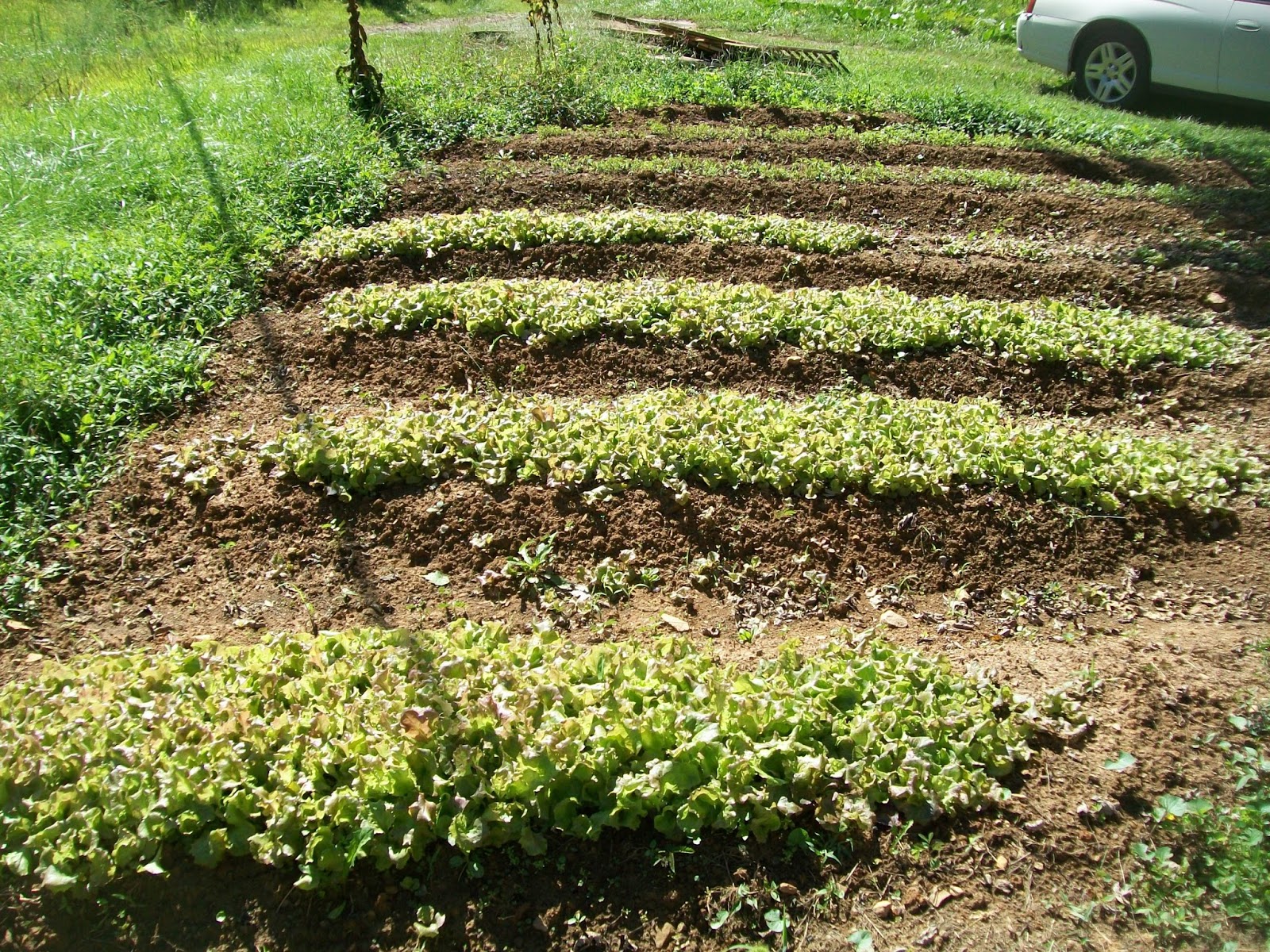
2. Create trenches in between sets of plants. When planting Peppers or tomato plants, or any plant-- hoe wide rows so that two plants grow side by side. The trench in between the plants will collect waterlike a chamber. This will allow the tips of roots to stay moist even if the sun has dried out the top of the dirt mound. For example, in the picture above, I have grown my lettuce in large wide mounds with wide walking paths (where water collects after heavy rainfall).
3. Root vegetables, peas, and greens can be crowded. Despite what the instructions say on the back of seed packets, many plants do not need much spacing. Greens benefit from crowding because it prevents weeds from sprouting in between. If I had a small amount of radish, turnip, peas, etc, I will squeeze all of these into one row rather than spreading the seeds for apart into different rows. The idea is that, you want to allow space for growing more variety of vegetables. See tip #4.
Side note: Root vegetables, peas, and greens (even cucumbers) can be grown in shadier locations of your garden during the Summer. Tomatoes, corn, peppers, and melons must get direct sunlight.
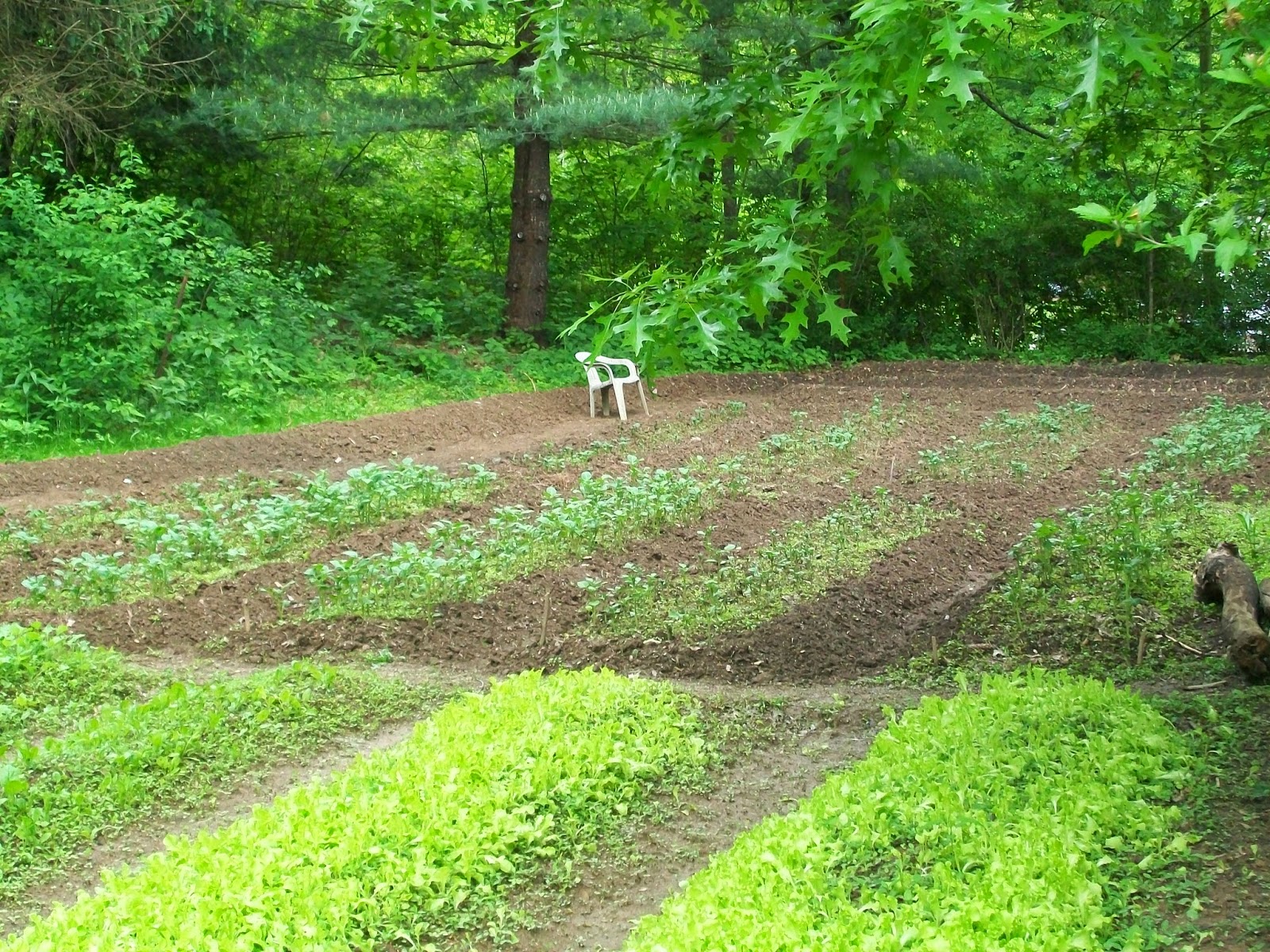
4. Vegetables do not need much spacing. Aside from tomatoes and corn, most vegetables and fruits can be crowded. Here is a good rule: when sewing with seed directly in the garden, do not try spacing any more than 2-3 inches apart; however for Fruits and vegetables you are Transplanting, space these plants no more than 10 inches apart. Considering beans, cucumbers, melons and vining plants can be grown on a trellis, there is hardly any need to space these plants far apart.
Remember to continue to hoe (or add) extra soil/mulch around plants to allow roots to spread.
5. Root vegetables, beans, peas, greens, zucchini, squash, and cucumbers should not be started indoors. These fast growing vegetables can be directly sewn into the ground. Peas, root vegetables and greens can be planted in March through April, depending on your zone. Zucchini, squash, cucumbers, and beans can be directly sewn after the last threat of frost, usually first week of May.
6. Tomatoes, peppers, and melons should be started indoors because of their long growing season. Allow tomato plants to grow 1 to 2 feet tall before transplanting to garden, then bury nearly the whole stalk (leaving top branches above ground). Use method #7 for proper tomato, pepper and melon growing.
7. Plant tomatoes 12 inches apart from each plant, be sure to tie your plants to post once they reach 2 feet in height. Continue to tie the main stem as the plant increases in height. In the following pictures I have demonstrated a technique that grows large tomatoes: first, plant two rows of plants close together for support, while leaving 2 foot wide walking paths in between. This technique prohibits weeds and bugs, allows drainage when dealing with floods, and creates an overall professional appearance. The wide paths in between the sets of rows allows for easier picking, hoeing, and tilling. By continuing to hoe dirt up around the tomato plants will promote larger and healthier stalks.
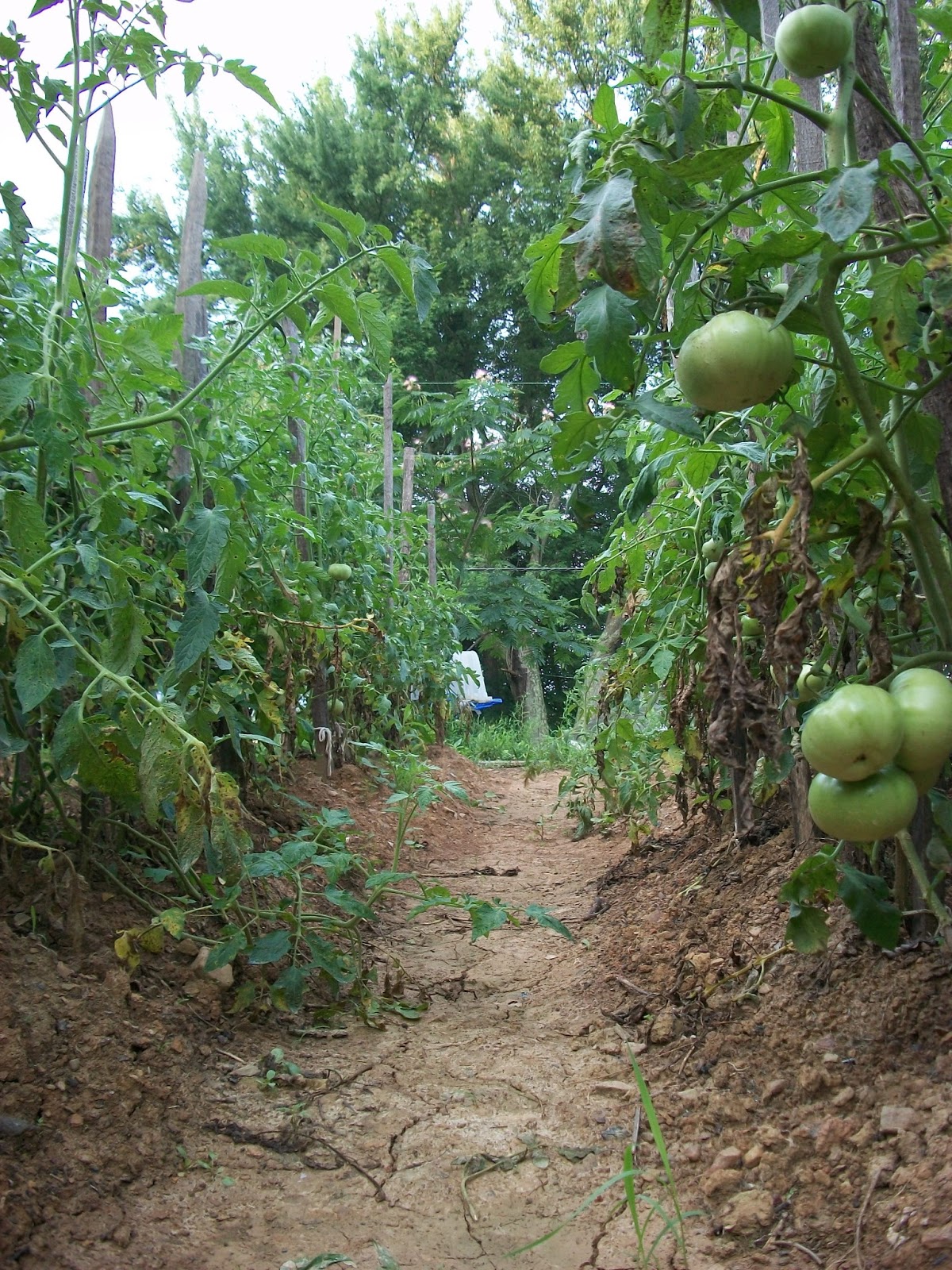
8. Make your own soil (compost) with food scraps. Compost is the most nutrient rich soil, and will boost your plants like fertilize. For more compost ideas and information go to two of my posts here, "Compost your food scraps..and get food back for free" and "What you need to know about compost". Compost is a versatile and can be used for starter plants, growing in buckets or pots; and use compost to fill a raised bed (go here for raised bed and container garden construction).
Particularly compost that is not completely decomposed, Tomato plants, peppers, and squash will always sprout and flourish in my raised beds I have full of compost. Actually, I wish I had about twenty raised beds full of food scraps because I would not need to sew seeds, I could just hope for the volunteer Tomatoes, peppers, and squash to sprout. Last year in one of my Strawberry beds, I had one volunteer Butternut Squash plant that exploded with 20 Butternut Squash fruits! I truly believe the location and compost within the strawberry bed made the Butternut Squash flourish. This year in a different Strawberry bed full of compost, one volunteer Cantaloupe plant produced 10 Cantaloupe fruits! I never have that much yield in a typical garden. From now on, I want to experiment by making additional raised beds, filling them with food scraps, and enjoying the ease and simplicity without tilling and hoeing, while enjoying the high yields of the food that Compost produces.
Along with creating your own soil, dry out grass to make your own Straw/mulch. Simply Mow your lawn, let the chopped grass dry out for a couple of days in the Sun, and collect the grass once it turns into straw. Collect leaves as well to use for mulching.
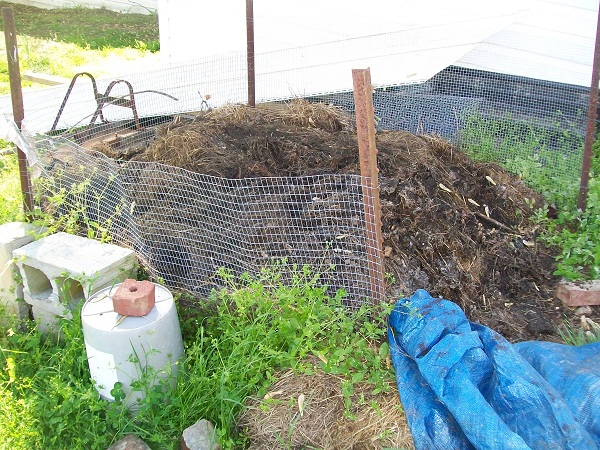
9. Transplant your fruits, vegetables, or bushes/trees in the evening. Sowing seeds during the Sunniest/hottest part of the day isn't harmful to the seeds, but transplanting your starters in the middle of the day in the Summer will scorch your plants and possibly kill them.
10. Watering plants during the evening. Following up on Tip #7, the most optimal time to water plants is during the evening, after 5pm because the water will not evaporate and instead the moisture will be retained during the Night. And considering plants do most of their growing during the night, it is optimal to water right before dark. Remember to water plants every other day until hot Summer temperatures--then I would suggest watering everyday, maybe even twice a day depending on your climate. Go to tip #18.
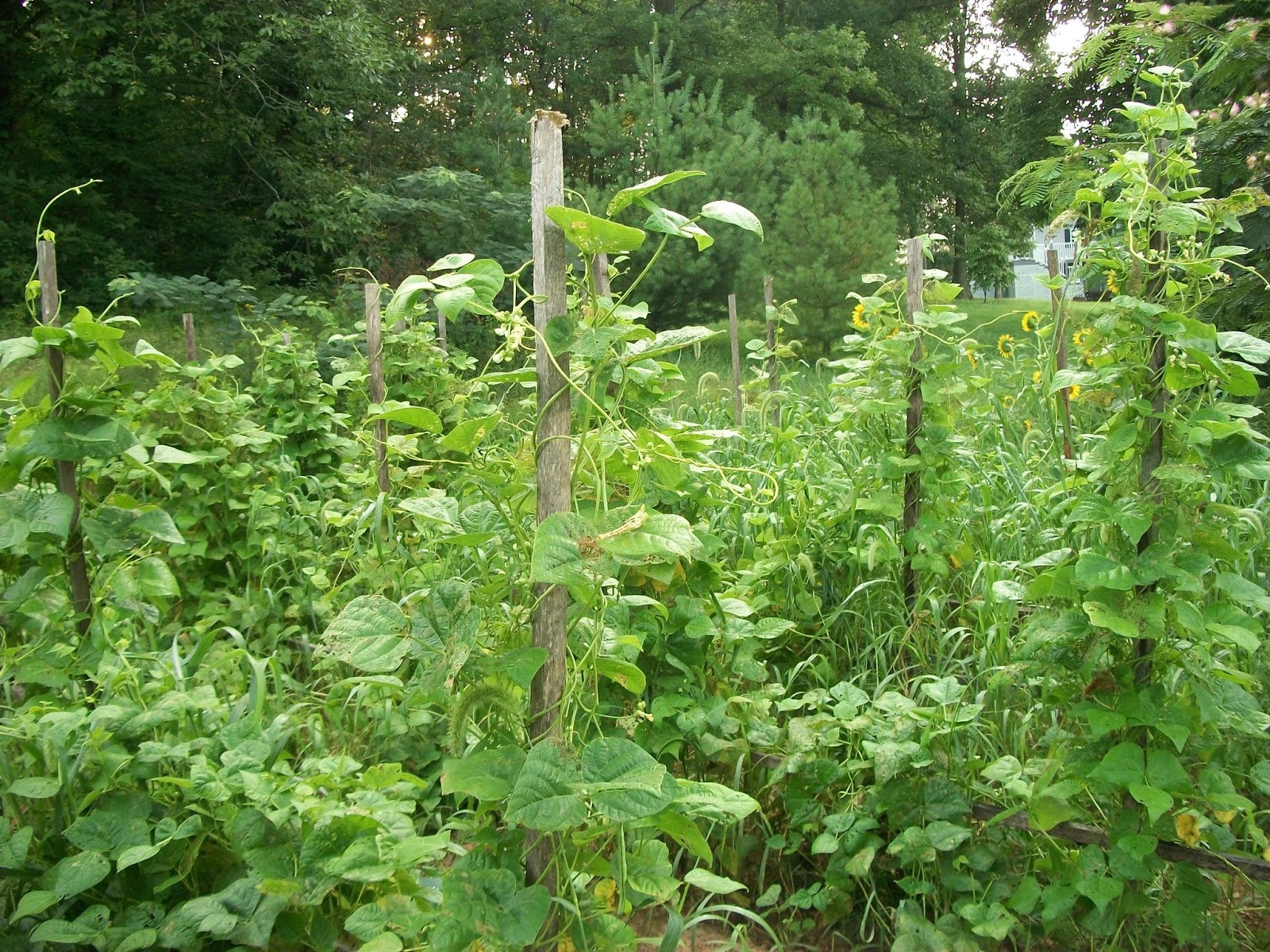
Beans crawling up posts
I COULD NOT INCLUDE ALL 20 TIPS ON THIS THREAD DUE TO EXCEEDING 10000 CHARACTERS. PLEASE CLICK THE LINK BELOW FOR FULL LIST OF GARDENING TIPS:
How to Garden for free & Comprehensive list of my top 20 gardening tips
-Cassie K, Vegans Living Off the Land

2. Create trenches in between sets of plants. When planting Peppers or tomato plants, or any plant-- hoe wide rows so that two plants grow side by side. The trench in between the plants will collect waterlike a chamber. This will allow the tips of roots to stay moist even if the sun has dried out the top of the dirt mound. For example, in the picture above, I have grown my lettuce in large wide mounds with wide walking paths (where water collects after heavy rainfall).
3. Root vegetables, peas, and greens can be crowded. Despite what the instructions say on the back of seed packets, many plants do not need much spacing. Greens benefit from crowding because it prevents weeds from sprouting in between. If I had a small amount of radish, turnip, peas, etc, I will squeeze all of these into one row rather than spreading the seeds for apart into different rows. The idea is that, you want to allow space for growing more variety of vegetables. See tip #4.
Side note: Root vegetables, peas, and greens (even cucumbers) can be grown in shadier locations of your garden during the Summer. Tomatoes, corn, peppers, and melons must get direct sunlight.
4. Vegetables do not need much spacing. Aside from tomatoes and corn, most vegetables and fruits can be crowded. Here is a good rule: when sewing with seed directly in the garden, do not try spacing any more than 2-3 inches apart; however for Fruits and vegetables you are Transplanting, space these plants no more than 10 inches apart. Considering beans, cucumbers, melons and vining plants can be grown on a trellis, there is hardly any need to space these plants far apart.
Remember to continue to hoe (or add) extra soil/mulch around plants to allow roots to spread.
5. Root vegetables, beans, peas, greens, zucchini, squash, and cucumbers should not be started indoors. These fast growing vegetables can be directly sewn into the ground. Peas, root vegetables and greens can be planted in March through April, depending on your zone. Zucchini, squash, cucumbers, and beans can be directly sewn after the last threat of frost, usually first week of May.
6. Tomatoes, peppers, and melons should be started indoors because of their long growing season. Allow tomato plants to grow 1 to 2 feet tall before transplanting to garden, then bury nearly the whole stalk (leaving top branches above ground). Use method #7 for proper tomato, pepper and melon growing.
7. Plant tomatoes 12 inches apart from each plant, be sure to tie your plants to post once they reach 2 feet in height. Continue to tie the main stem as the plant increases in height. In the following pictures I have demonstrated a technique that grows large tomatoes: first, plant two rows of plants close together for support, while leaving 2 foot wide walking paths in between. This technique prohibits weeds and bugs, allows drainage when dealing with floods, and creates an overall professional appearance. The wide paths in between the sets of rows allows for easier picking, hoeing, and tilling. By continuing to hoe dirt up around the tomato plants will promote larger and healthier stalks.

8. Make your own soil (compost) with food scraps. Compost is the most nutrient rich soil, and will boost your plants like fertilize. For more compost ideas and information go to two of my posts here, "Compost your food scraps..and get food back for free" and "What you need to know about compost". Compost is a versatile and can be used for starter plants, growing in buckets or pots; and use compost to fill a raised bed (go here for raised bed and container garden construction).
Particularly compost that is not completely decomposed, Tomato plants, peppers, and squash will always sprout and flourish in my raised beds I have full of compost. Actually, I wish I had about twenty raised beds full of food scraps because I would not need to sew seeds, I could just hope for the volunteer Tomatoes, peppers, and squash to sprout. Last year in one of my Strawberry beds, I had one volunteer Butternut Squash plant that exploded with 20 Butternut Squash fruits! I truly believe the location and compost within the strawberry bed made the Butternut Squash flourish. This year in a different Strawberry bed full of compost, one volunteer Cantaloupe plant produced 10 Cantaloupe fruits! I never have that much yield in a typical garden. From now on, I want to experiment by making additional raised beds, filling them with food scraps, and enjoying the ease and simplicity without tilling and hoeing, while enjoying the high yields of the food that Compost produces.
Along with creating your own soil, dry out grass to make your own Straw/mulch. Simply Mow your lawn, let the chopped grass dry out for a couple of days in the Sun, and collect the grass once it turns into straw. Collect leaves as well to use for mulching.

9. Transplant your fruits, vegetables, or bushes/trees in the evening. Sowing seeds during the Sunniest/hottest part of the day isn't harmful to the seeds, but transplanting your starters in the middle of the day in the Summer will scorch your plants and possibly kill them.
10. Watering plants during the evening. Following up on Tip #7, the most optimal time to water plants is during the evening, after 5pm because the water will not evaporate and instead the moisture will be retained during the Night. And considering plants do most of their growing during the night, it is optimal to water right before dark. Remember to water plants every other day until hot Summer temperatures--then I would suggest watering everyday, maybe even twice a day depending on your climate. Go to tip #18.

Beans crawling up posts
I COULD NOT INCLUDE ALL 20 TIPS ON THIS THREAD DUE TO EXCEEDING 10000 CHARACTERS. PLEASE CLICK THE LINK BELOW FOR FULL LIST OF GARDENING TIPS:
How to Garden for free & Comprehensive list of my top 20 gardening tips
-Cassie K, Vegans Living Off the Land

